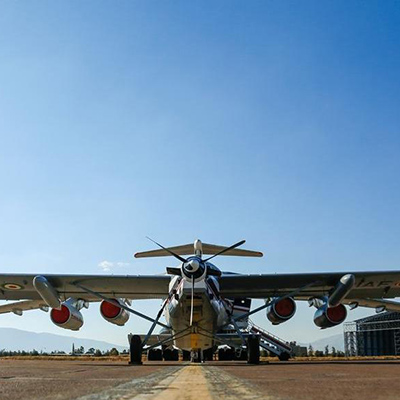Sites
Shiraz 7th Tactical Air Base
Mohsen Shir-Muhammad
196 Views
The Shiraz 7th Tactical Air Base was one of the air bases built at the old airport near Shiraz. It played a key role in defending the country’s airspace during the Iran-Iraq War.
The establishment of the Shiraz base dates back to the mid-1950s. In 1956, the Shiraz Air Base was formed by the deployment of two single-engine L-20 aircraft at Shiraz’s old airport.[1] Then, in 1963, the 5th Transport Air Base was established in Shiraz with five C-130 Hercules transport aircraft. Seven years later, it was renamed the 7th Independent Transport Air Base. On February 20, 1971, with the deployment of two squadrons of F-4 fighter-bombers, the base’s air capabilities increased, and it became known as the 7th Tactical Air Base. In the meantime, the C-130 aircraft unit was expanded to two squadrons. In early 1975, the Tactical Air Command Headquarters was formed at the 7th Air Base, and all tactical air bases were placed under its command. In 1977, a squadron of 15 F-14 fighter jets was deployed at the base, enhancing its role in protecting the skies of southern Iran.
Following the victory of the Islamic Revolution in 1979, new changes were introduced in the Iranian Army Air Force, including the dissolution of the Tactical Air Command Headquarters. Tactical air bases, including the 7th Air Base, were once again placed under the command of the Air Force Operations Deputy Command.[2]
With the onset of internal crises in various parts of the country after the Islamic Revolution, the Shiraz base supported the armed forces in countering anti-revolutionary groups.[3] In 1980, on the eve of the Iran-Iraq War, the 7th Air Base was equipped with 16 F-14 fighter jets, 22 C-130 transport aircraft, and 6 P-3F maritime patrol aircraft.[4]
The Shiraz base was among the air bases attacked by Iraq on September 22, 1980, though the attack caused no significant damage.[5] On the same day, the 7th Tactical Air Base took action to counter the enemy, including 9 combat air patrol sorties by F-14 fighter jets and 16 transport sorties by C-130 aircraft to move troops and military cargo.[6] The following day, the Shiraz base participated in Operation Kaman-99, a large-scale air strike on Iraq’s main military bases and centers, with F-14 fighter jets conducting 12 sorties to support friendly aircraft and counter enemy air attacks.[7]
One of the units stationed at the Shiraz base was the Long-Range Reconnaissance Squadron, equipped with four-engine P-3F maritime patrol aircraft.[8] At the start of the Iran-Iraq War, the Air Force specialists restored these aircraft which had been grounded for months after the Revolution to operational status.[9] The Long-Range Reconnaissance Squadron based in Shiraz conducted numerous flights over the Persian Gulf, the Strait of Hormuz, and the Sea of Oman, playing a key role in identifying foreign military and commercial vessels in these areas. The data obtained from P-3F flights, along with photographs taken by the aircraft’s cameras, were sent to the Air Force Intelligence and Reconnaissance Command and the Navy. This information was critical for analysis, decision-making, and subsequent actions taken by the Army, particularly the Navy.[10]
The Shiraz base also played a role in Operation Morvarid (November 28, 1980) during which Iraq’s navy was destroyed. On that day, F-14 fighter jets conducted nine combat air patrol sorties to support the Navy, and they shot down one enemy aircraft.[11]
The C-130 aircraft of the Shiraz base were also involved in transporting ammunition, equipment, and military personnel during various operations in the Iran-Iraq War. For example, they transported 1500 Iranian troops from Mashhad to Khuzestan to take part in Operation Beit al-Muqaddas.[12]
During the Tanker War in the Persian Gulf, F-14 fighter jets stationed in the 7th Air Base conducted aerial refueling and round-the-clock flights to escort oil tankers, preventing enemy air attacks and ensuring the continuation of Iran’s oil exports.[13]
In late 1985, the F-14 aircraft of this base were transferred to the Isfahan Air Base to reduce maintenance costs. Subsequently, in 1986, a squadron of F-5 training fighter jets was stationed at the Shiraz base.[14]
On October 15, 1986, during an enemy bombing of both military and civilian sections of Shiraz Airport, two Boeing 747 aircraft were completely destroyed, and another one was significantly damaged. A civilian passenger aircraft was also damaged in this attack.[15]
After the Iran-Iraq War, the Shiraz base was renamed the Martyr Doran Air Zone in honor of Major General Pilot Abbas Doran, who was martyred during the bombing of Baghdad.[16] In addition, new aircraft, including Su-24 and Ilyushin Il-76 heavy transport aircraft, were added to the base’s fleet.[17] Currently, major overhauls of Su-24 bombers and C-130 transport aircraft are conducted at the Shiraz base,[18] and a Su-24 flight simulator, designed by the Iranian scientists and specialists, is used for training pilots.[19]
Hassan Shalchian, Muhammad Farahavar, Muhammad Masbouq, and Yadollah Khalili were among the most prominent commanders and pilots who served in the Shiraz base during the Iran-Iraq War.[20] Currently, Brigadier General Pilot Masoud Jafari commands the Martyr Doran Air Base in Shiraz.[21]
[1] Ariyani, Hamed, Parvaz az Fars ta Aseman-e Khalij-e Fars (Flight from Fars to the Skies of the Persian Gulf), Mahname-ye Saf, No. 417, Bahman 1394, p. 19.
[2] Namaki-Araqi, Alireza va Digaran, Tarikh-e Nabardhaye Havayi – Amaliyat-e Kaman-99 (History of Aerial Battles – Operation Kaman-99), Vol. 3, Tehran, Markaz-e Entesharat-e Rahbordi-ye Nahaja, 1396, p. 58.
[3] Ariyani, Hamed, Ibid., p. 20.
[4] Zeynali, Nasrollah, Amad va Poshtibani-ye Havayi dar Defa Muqaddas (Air Logistics Support in the Sacred Defense), Tehran, Markaz-e Entesharat-e Rahbordi-ye Nahaja, 1394, Pp. 261, 264.
[5] Ansari, Mahdi va Digaran, Rouzshomar-e Jang-e Iran va Araq (Chronology of the Iran-Iraq War), Vol. 4, Tehran, Markaz-e Motaleat va Tahqiqat-e Jang, 2nd ed., 1375, p. 57.
[6] Heyat-e Tadvin-e Tarikh-e Defa Muqaddas, Taqvim-e Mostanad-e Amalkard-e Niru-ye Havayi Artesh-e Jomhouri-ye Eslami-ye Iran (Documented Calendar of the Islamic Republic of Iran Air Force Performance), Vol. 3, Mehr 1359, Tehran, Markaz-e Entesharat-e Rahbordi-ye Nahaja, 1397, p. 26.
[7] Ibid., p. 63; Namaki-Araqi, Alireza va Digaran, Ibid., Pp. 30, 97, 98.
[8] Shir-Muhammad, Mohsen, Cheshman-e Oqab (Eagle Eyes), Tehran, Markaz-e Entesharat-e Rahbordi-ye Nahaja, 1396, p. 50.
[9] Zeynali, Nasrollah, Ibid., p. 320.
[10] Shir-Muhammad, Mohsen, Cheshman-e Oqab (Eagle Eyes), p. 50; Shir-Muhammad, Mohsen, Pakbazane Arseh-ye Eshq (Devotees of Love’s Realm), Mahname-ye Sanaye-ye Havayi, No. 315, Mordad to Mehr 1397, p. 28.
[11] Masbouq, Muhammad va Alireza Javaheri, Amaliyat-e Morvarid (Operation Morvarid), Tehran, Markaz-e Entesharat-e Rahbordi-ye Nahaja, 1394, Pp. 171, 172; Namaki-Araqi, Alireza va Digaran, Ibid., p. 77.
[12] Ariyani, Hamed, Ibid., p. 20.
[13] Ibid., p. 20.
[14] Namaki-Araqi, Alireza va Digaran, Ibid., p. 58.
[15] Ansari, Mahdi va Digaran, Ibid., Pp. 351, 352.
[16] Ariyani, Hamed, Ibid., p. 19; Khabargozari-ye Fars (Fars News Agency), 13 Esfand 1391, www.farsnews.ir/news/13911212001049.
[17] Ariyani, Hamed, Ibid., p. 21.
[18] Ibid., Pp. 21, 32.
[19] Shabihsaz-e Sukhoi-24 (Sukhoi-24 Simulator), Mahname-ye Saf, No. 417, Bahman 1394, p. 32.
[20] Masbouq, Muhammad va Alireza Javaheri, Ibid., Pp. 193, 198, 203; Namaki-Araqi, Alireza va Digaran, Ibid., Pp. 59, 60.
[21] Khabargozari-ye Fars (Fars News Agency), 6 Farvardin 1399, www.farsnews.ir/news/13990106000323.





